Rain Gardens
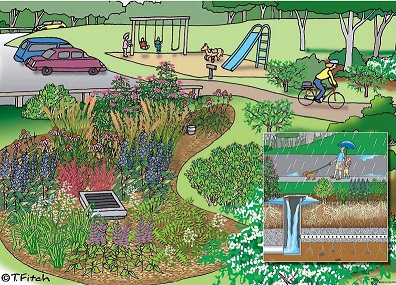
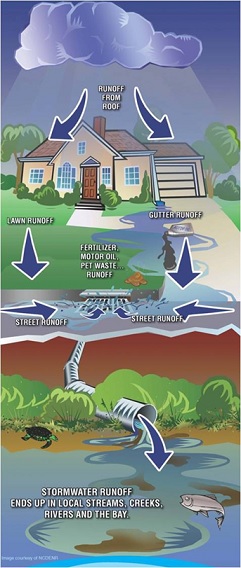
Illustration: stormwater runoff and
nonpoint source pollution
A rain garden is a landscape tool that can provide many environmental benefits while adding color and beauty to your yard. Rain gardens provide a beautiful solution for yards with poor drainage. A strategically placed and well-designed garden captures excess rainwater from roofs, gutters, and paved areas and uses plants and special soils to absorb the water. Gardens can replace muddy low spots with beautiful planted areas.
Environmental Benefits
Rain gardens…
- Collect and filter stormwater from roofs, paved surfaces and lawns.
- Help recharge natural groundwater.
- Reduce soil erosion.
- Reduce nonpoint source pollution to our streams and the Chesapeake Bay. Nonpoint source (NPS) pollution is caused when rainfall or snowmelt, moving over and through the ground, picks up and carries natural and human-made pollutants into lakes, rivers, wetlands, streams, coastal waters, and groundwater. (See EPA: Nonpoint Source Pollution)
- Provide valuable habitat and food sources for birds, and pollinators such as butterflies.
Economic Benefits
Rain gardens…
- Reduce outdoor water use for landscaping. Once installed, rain gardens seldom need any watering.
- Improve drainage in yards, potentially eliminating the need for very expensive underground drainage improvements.
- Reduce backups in the stormwater system so GHI will not have to spend as much time pumping out flooded crawlspaces.
Rain gardens can be planted in nearly all yard types. Low, sunny spots provide the best sites for maximizing colorful flowers, but many attractive plants are available for shadier spots. GHI has prepared a helpful brochure - Rain Gardens - that provides tips on planning, building, planting, and maintaining a rain garden in GHI as well as a plant list of some recommended plants that will grow in our area.
Demonstration Garden Sites
To showcase rain garden techniques in our community, GHI has developed demonstration rain gardens at various sites described below. Each site has an educational sign. Drop by to check out rain gardens in action.
Seeking Volunteers
The Woodlands Committee is seeking volunteers with knowledge of forest and wetlands ecology and some plant knowledge and familiarity with plant life cycles to help maintain the rain gardens. A maintenance manual (20 Court Ridge Rain Garden Maintenance Manual) has been prepared to help maintenance staff and volunteers become familiar with rain garden ecology and identification of both native and invasive plants. The manual includes a chart that lists the most common maintenance tasks with recommended seasonal application. Interested individuals should contact the staff liaison listed for the Woodlands Committee.
Rain Garden: 20 Court Ridge Road
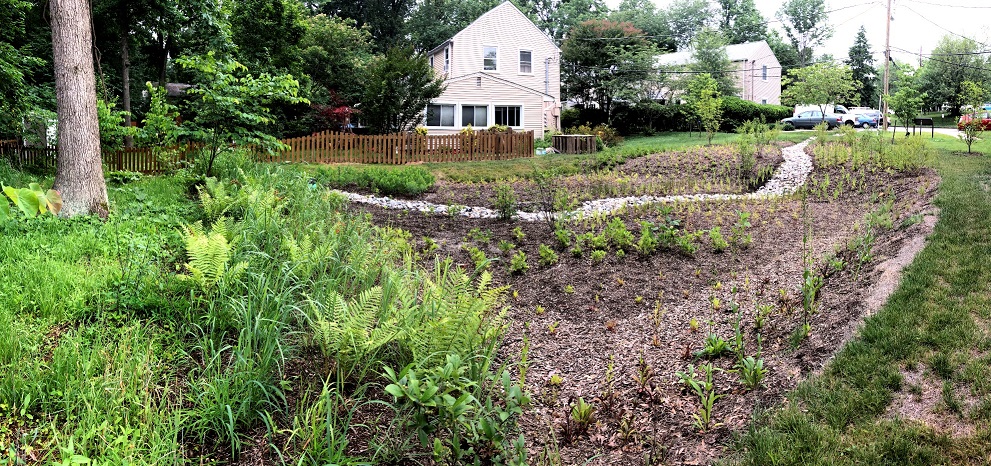
GHI’s newest rain garden, located at 20 Court Ridge Road, is part of a living stormwater treatment system, called a BayScape, that is designed to address stormwater runoff from the impervious surfaces affecting the court, including the 20 Court and neighboring Green Ridge House parking lots, roof surfaces, sidewalks, and decks.
BayScape is a term coined by the U.S. Fish and Wildlife Service to describe a landscape “planted and maintained to benefit people, the local environment, and the Chesapeake Bay.” A BayScape uses all native plants to provide habitat for local and migratory animals, improve water quality, and reduce the need for chemical pesticides and herbicides. See U.S. Fish & Wildlife Service/BayScapes.
Additional runoff at the site comes off the adjacent section of Ridge Road that drains downhill on a grassy slope toward 20 Court homes. A stone diaphragm that intercepts water near the bottom of this slope is another feature of stormwater management at the site.
The 20 Court Rain Garden captures, slows, and filters stormwater runoff. It uses plants and soil mixes to mimic natural filtering processes that remove pollutants. Water enters the rain garden through a curb cut in the parking area and passes over a stone swale that conveys water through the garden.
The water flows into a landscaped, shallow depression and temporarily ponds on the surface. It then slowly moves through the filter bed underneath the surface and is absorbed by the roots of the rain garden plantings and surrounding soil. The rain garden soil and plantings serve as the final treatment step for stormwater runoff, capturing sediment and preventing pollutants from entering the local waters. Any excess water not absorbed is collected by the underdrain (perforated pipes beneath the filter bed) and discharged into the surrounding woodlands.
Native plants are an important component of the 20 Court Rain Garden. They are especially suited to the soil conditions and ecology of this region, help filter out harmful pollutants, and provide habitat for pollinators and other wildlife.
The rain garden is designed with planting zones, from wetland plants in the center to drier-adapted plants at the outer margins. The plants are selected because of their ability to adapt to varying conditions at the site, since the garden may manage water in both greater and lesser volumes than anticipated.
Additional plantings consisting of understory trees, native woodland grasses, and a woodland edge meadow surround the white oak tree behind the rain garden. These plantings are designed to serve as a buffer to capture runoff that overflows the rain garden during extreme precipitation events. The rain garden and adjacent buffer work together to form the BayScape.
The 20 Court stormwater management improvements were installed and planted between September 2017 and April 2018 under the direction of the GHI Storm Water Management Task Force. The project was funded through the support of the Prince George’s County Department of the Environment under the Stormwater Stewardship Grant Program administered by the Chesapeake Bay Trust.
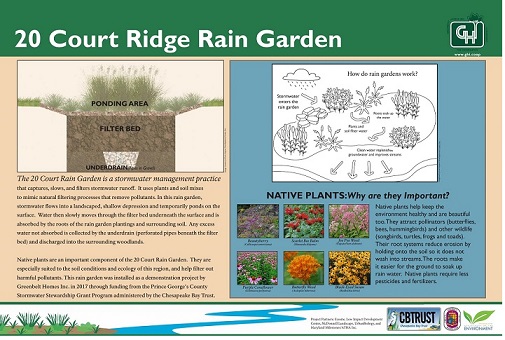 Rain garden educational sign designed by Maryland Milestones/Anacostia Trails Heritage Area |
Rain Garden: 6 Court Plateau Place
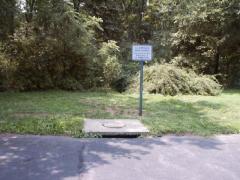 Before
Before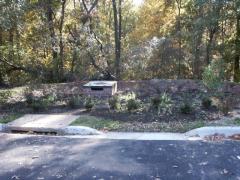 After
AfterDuring the summer of 2007, GHI installed a specially designed 600-square foot rain garden near the parking lot at 6 Court Plateau Place during the major renovation of the court parking lot. This high-visibility sight was selected for a demonstration garden due in large part to the damage caused by stormwater runoff into the streams and forest area downhill from the parking lot. Prior to construction of the garden, all rainfall landing on the 12,000 square foot parking lot flowed directly to a stormwater drain pipe that dumped into the GHI Woodlands and City of Greenbelt Forest Preserve. This meant for every 1” of rainfall, more than 6,700 gallons of water gushed out of the pipe, causing extensive erosion to the stream areas below.
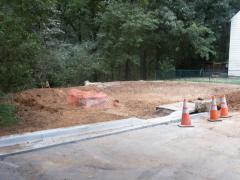 Excavated garden area
Excavated garden area Filter cloth installed
Filter cloth installedover gravel layer
 Installing special rain garden
Installing special rain gardensoil mix over filter cloth
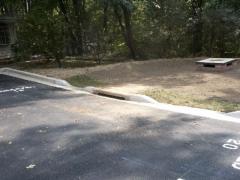 Garden after final grading
Garden after final gradingbefore planting
This garden was designed to capture the majority of the rainfall runoff from the lot and allow it to slowly soak into the ground instead of causing erosion in the streams. Erosion below this rain garden has been significantly reduced.
A mulch layer and native plants and trees in the garden help to filter out pollutants such as anti-freeze and oil from cars and ice melt products from the lot as well as sediment and excessive nutrients (mainly nitrogen and phosphorus), instead of sending them directly to the streams - and ultimately to the Chesapeake Bay. This garden was designed to provide all of these benefits while supporting an attractive mix of trees, shrubs, wildflowers, and decorative grasses to attract birds and butterflies and add vibrant color to the court.
The garden also contains a special bypass drain to allow excessive water from heavy rain storms or large snow melt to exit the garden without causing overflow into the parking lot area.
Funding for this demonstration project, project sign, and educational brochure was provided by the Chesapeake Bay Trust .
Read more about the planning and implementation of this project in detail.
Rain Garden: 33 Court Ridge Road
 Before
Before After
AfterDuring the summer of 2006, GHI staff created two demonstration gardens along Ridge Road at the intersection with Hamilton Place near 33 Court Ridge. These gardens – a larger sun garden and a smaller shade garden covered by the tree at the entrance to the court – capture rooftop runoff from a block of rental garages. Prior to installing these rain gardens, this site would frequently flood, causing erosion and entrance of water into the adjacent garages.
The gardens were designed to provide an attractive mix of shrubs, grasses, and wildflowers that would add vibrant color to that area. Funding for this demonstration project and educational brochure was provided by the Chesapeake Bay Trust
Rain Garden Publications
- Rain Gardens: A Landscape Tool to Improve Water Quality
This colorful and informative "how-to" brochure is designed specifically for GHI members and recommends plants that work well in our community. Funding for this brochure was provided by the Chesapeake Bay Trust. - Recommended Plant List for Rain Gardens in GHI
This excel spreadsheet lists a number of flowers, grasses, shrubs, and trees that will generally grow well in rain gardens in our area. This list is not complete and all plants will not work in all yard conditions, but it is a good starting point. - Rain Gardens in Greenbelt
Contains information from the sign for the 6 Court Plateau Place rain garden. - Parking Lot Rain Garden Retrofit
Detailed description of the rain garden installation at 6 Court Plateau Place. - 20 Court Ridge Rain Garden Maintenance Manual.
- Rain Garden Workshop Presentation
An informative PowerPoint presentation on rain gardens by the Prince George’s County Department of the Environment that provides detailed information on designing and constructing rain gardens, tips on selecting locations, photos of suitable plants, and more. - Rain Gardens: A How-To Manual for Homeowners
An excellent brochure created by the University of Wisconsin and the Wisconsin Department of Natural Resources that demonstrates detailed rain garden construction techniques. Note: Some plants recommended in this brochure will not prosper in Maryland and are not readily available.
Useful Links
- Prince George's County Rain Check Program
This site contains information on rebates for homeowners in the county (including GHI residents) who install a rain garden. The site includes useful links to a fact sheet and to rain garden guidelines in Prince George’s County. The site also has information on additional eligible stormwater management techniques—rain barrels and other practices—that homeowners can install and receive a rebate. - Install a Rain Garden (MyGreenMontgomery.Org)
This Montgomery County webpage includes links to a manual for how to install a rain garden and an instructional video. - Residential Low Impact Development
An interactive website for viewing a number of Low Impact Development (LID) tools for homeowners such as rain gardens, conservation plantings, grass swales, and more. - Rain Gardens: Gardening with Water Quality in Mind
A good resource page for learning more about rain gardens and how to construct one in your yard. - Raingardens.org
Resource page on general rain garden information. - Environmental Protection Agency (EPA): Nonpoint Source Pollution
Good source for basic information, resources, and restoration efforts concerning nonpoint source pollution of waterways. - U.S. Fish & Wildlife Service/BayScapes
Good source to learn more about BayScapes, their environmental value, and how to create and maintain them. Also has native plant guides and a list of native plants nurseries in the Chesapeake Bay Watershed. - Chesapeake Bay Trust (CBT)
A nonprofit grant-making organization dedicated to improving the watersheds of the Chesapeake Bay region. CBT awards grant funding each year to nonprofit and community organizations throughout the region for hands-on projects that work toward a cleaner, healthier Chesapeake watershed. Its mission is to promote public awareness and participation in the restoration and protection of the water quality and aquatic and land resources of the Chesapeake Bay region. - Maryland Native Plant Society Nursery Listing
The Maryland Native Plant Society (MNPS) publishes a list that includes dealers for both retail and wholesale markets in the Mid-Atlantic region, including Maryland, the District of Columbia, Virginia, Pennsylvania, and West Virginia. Note: MNPS provides this list only for the convenience of those who wish to purchase native plants. It is based primarily on information received from the vendors, and therefore is not intended as an endorsement or recommendation of any of the vendors listed. Some vendors sell non-native plants in addition to native plants. Individuals should contact the vendors for additional information about their products. The website also includes other information about shopping for native plants.




